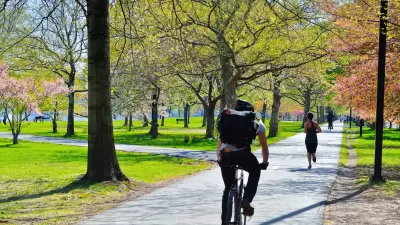A recent study by the U.S. Forest Service shows that out of 20 cities surveyed, 19 showed a decline in tree cover. With their demonstrated benefits to public health, property values, and reducing pollution, Tod Newcombe asks why they're disappearing.
Although a street tree's environmental and aesthetic value is seemingly immeasurable, the U.S. Forest Service has apparently quantified the value of a single urban tree at $2,500. Whether calculable or not, despite their benefits, the Forest Service found that American cities suffer a net loss of 4 million trees annually.
"The reasons for such a broad decline vary, according to Eric J. Greenfield, a forester for the U.S. Forest Service and co-author of the study," says Newcombe. "He mentions wind storms, drought, pest infestation, old age and removal as some of the key contributors. But the last problem cited might be the biggest contributor as cities continue to cut down trees to make way for new development."
So what can be done to reverse this decline? Cities such as New York and Boston have started tree planting campaigns, with varying success. Newcombe finds hope in other indicators:
"The good news is that our understanding of how trees benefit cities has been extensively documented, and more people are being trained in urban forestry. Software tools like i-Tree have been developed that can accurately assess and analyze an urban forest, and community groups continue to raise funds to pay for tree plantings."
"Hopefully," concludes Newcombe, "as cities emerge from the last vestiges of the Great Recession, we will see a revival of interest -- as well as investment -- in our urban canopy."
FULL STORY: Tree Population Falling in Cities

Alabama: Trump Terminates Settlements for Black Communities Harmed By Raw Sewage
Trump deemed the landmark civil rights agreement “illegal DEI and environmental justice policy.”

Planetizen Federal Action Tracker
A weekly monitor of how Trump’s orders and actions are impacting planners and planning in America.

The 120 Year Old Tiny Home Villages That Sheltered San Francisco’s Earthquake Refugees
More than a century ago, San Francisco mobilized to house thousands of residents displaced by the 1906 earthquake. Could their strategy offer a model for the present?

Ken Jennings Launches Transit Web Series
The Jeopardy champ wants you to ride public transit.

BLM To Rescind Public Lands Rule
The change will downgrade conservation, once again putting federal land at risk for mining and other extractive uses.

Indy Neighborhood Group Builds Temporary Multi-Use Path
Community members, aided in part by funding from the city, repurposed a vehicle lane to create a protected bike and pedestrian path for the summer season.
Urban Design for Planners 1: Software Tools
This six-course series explores essential urban design concepts using open source software and equips planners with the tools they need to participate fully in the urban design process.
Planning for Universal Design
Learn the tools for implementing Universal Design in planning regulations.
Clanton & Associates, Inc.
Jessamine County Fiscal Court
Institute for Housing and Urban Development Studies (IHS)
City of Grandview
Harvard GSD Executive Education
Toledo-Lucas County Plan Commissions
Salt Lake City
NYU Wagner Graduate School of Public Service





























